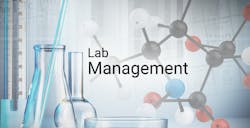Much has been written about laboratory regulations and the regulatory process. Why publish another article now? Changes to the healthcare environment in the United States over the past few years have left hospitals and laboratories asking questions about resources. How does the laboratory continue to provide quality service to patients and practitioners while reimbursements decrease? How do regulatory requirements fit into this same picture? How can the laboratory stay ahead of new regulations?
Many laboratories do maintain readiness throughout the inspection cycle. These facilities share common traits. This article will identify success strategies when dealing with regulatory compliance. In general, these strategies fall into three categories: 1) knowledge, 2) awareness, and 3) good management practices.
Knowledge
Knowledge of how the regulatory process works and which agencies inspect and accredit laboratories is key to maintaining readiness. In the U.S., laboratory testing for disease diagnosis, prevention, treatment, and monitoring must satisfy the requirements of the Clinical Laboratory Improvement Amendments (CLIA) of 1988. Compliance with the CLIA requirements is a prerequisite for receiving reimbursements from federally-funded programs such as Medicare and Medicaid. The Centers for Medicare and Medicaid Services, (CMS), the Food and Drug Administration (FDA), and the Centers for Disease Control and Prevention (CDC) all have an oversight role within the CLIA regulations, with CMS taking responsibility for the biannual inspection process called for in the regulations.
For many years prior to CLIA, several agencies provided accrediting services for laboratories that included an inspection process as well. CMS provides criteria for these agencies to work on behalf of CMS with a category called “Deemed Status.” The agencies must ensure that the CLIA regulations are enforced, but the agencies are allowed to add requirements to their particular accreditation process.
The following is a list of approved accreditation organizations under CLIA:
- American Association of Blood Banks (AABB), 8101 Glenbrook Road, Bethesda, Maryland 20814-2749, (301) 907-6977, www.aabb.org
- American Association for Laboratory Accreditation (A2LA), 5202 Presidents Court, Suite 220, Frederick, Maryland 21703, (301) 644-3248, www.a2la.org
- American Osteopathic Association, 142 East Ontario Street, Chicago, Illinois 60611, (312) 202-8070, www.osteopathic.org
- American Society for Histocompatibility and Immunogenetics (ASHI), 15000 Commerce Parkway, Suite C, Mt. Laurel, New Jersey 08054, (856) 638-0428, www.ashi-hla.org
- COLA, 9881 Broken Land Parkway, Suite 200, Columbia, Maryland 21046-1195, (410) 381-6581, www.cola.org
- College of American Pathologists (CAP), 325 Waukegan Road, Northfield, Illinois 60093-2750, (800) 323-4040, www.cap.org
- Joint Commission, One Renaissance Boulevard, Oakbrook Terrace, Illinois 60181, (630) 792-5000, www.jointcommission.org
These agencies all have personnel willing to help laboratories through the accreditation process. They provide valuable information, education, and other resources to laboratories that choose to use their services.
Although a laboratory is accredited by one of these agencies, CMS selects a percentage of laboratories each year for a validation inspection. This additional inspection may occur in the months just following inspection by the accreditation organization. CMS may also send in an inspection team at any time in response to a complaint. All laboratories need to be aware of the possibility of a CMS inspection and how that may differ from the inspection from an accrediting agency. The major difference is that the CMS inspection will be based solely on the CLIA regulations. A CMS inspection is usually a multi-day activity with one or more CMS professional surveyors.
Awareness
Even though the regulations have been in place for many years, the interpretation of those regulations changes over time. Sometimes the changes occur because of technology enhancements in the industry. Other changes can be related to an evolving understanding of the regulatory process. Still others may be related to the clinical utilization of laboratory information.
Example A: Personnel records and requirements
The CLIA regulations include specific education, training, and experience requirements for particular laboratory personnel. Several years ago, CMS discovered that some laboratory personnel were falsifying information regarding these requirements. What followed was increased scrutiny of personnel records during CMS inspections. The agencies with deemed status under CLIA also began a more focused review of personnel records. Many laboratories did not require job applicants to provide “proof” of education in the form of copies of diplomas or transcripts prior to this renewed focus and experienced inspection deficiencies because the facility could not produce this proof when asked by an inspector. These citations were so numerous that they fell into the top 10 deficiencies for CMS and the deemed status accrediting agencies.
Example B: Competency assessment
The CLIA regulations include a section on assessing the competency of staff. Six elements of competency assessment are specifically listed in the regulations for both moderately complex and highly complex testing. For many years, laboratories utilized these six elements as part of competency assessment but did not necessarily use all six elements in the assessment of every test system. All of the regulatory and accrediting agencies now have a renewed focus on the six elements of competency for each test system. Laboratories that do not include all six elements in their competency assessments risk being cited.
CMS and the other accrediting agencies track the number and types of deficiencies they issue each year. These lists provide a valuable resource for determining when interpretation of the regulations may be changing. The following tables show the 2015 top 10 deficiency lists for several of these agencies.
CMS
The CLIA regulations are divided into conditions. Each condition includes a group of standards. A CMS deficiency can then be classified as standard (noncompliance with a particular standard) or condition (nonconformance with a group or category of standards). Condition-level deficiencies are more serious and carry higher penalties than standard deficiencies. Table 1 and Table 2, respectively, list the CMS top 10 condition-level and top 10 standard deficiencies for 2015.
Personnel requirements and qualifications appear in six out of ten on the list of condition-level deficiencies. In some cases, the deficiency refers to the laboratory director, but the technical consultant supervisor and testing personnel also appear on the list.
Laboratories should create a crosswalk of their current job descriptions with the CLIA personnel standards to ensure that anyone serving in one of the CLIA-defined roles has the appropriate, documented education, training, and experience to perform his/her role. These requirements should also be incorporated into the hiring process when screening applicants for these positions.
Proficiency testing also appears on this list and continues to be a major focus for CMS and the other agencies.
The standard-level deficiencies also include one personnel standard along with competency assessment. Reagent storage according to manufacturer’s instructions (includes humidity requirements), calibration verification, and other checks for quality in analytical systems also made this list.
College of American Pathologists (CAP)
CAP is an organization of pathologists that provides multiple resources to laboratories in the U.S. and across the globe. Accreditation is one of many facets of the services provided by CAP. Its accreditation process is based on a series of requirement checklists, which include the CLIA standards as well as other requirements. Table 3 shows the CAP top ten deficiencies in 2015.
Problems with competency assessment led the list of CAP deficiencies for 2015. Method comparisons, procedure manuals, proficiency testing, equipment function checks, and documentation also resulted in a significant number of deficiencies.
COLA
COLA is an independent, non-profit accreditor. Its education program and standards enable clinical laboratories and staff to meet U.S. CLIA and other regulatory requirements. Table 4 delineates COLA’s top 10 deficiencies of 2015.
Competency assessment problems also top the list of COLA deficiency citations. Four of the top ten deficiencies involve personnel not fulfilling their CLIA responsibilities. Proficiency testing and calibration verification also appear on the list.
The Joint Commission
The Joint Commission is an independent, not-for-profit organization that accredits and certifies healthcare organizations and programs, including laboratories across the U.S. Table 5 shows the top 10 deficiencies it recorded last year.
Proficiency testing participation topped the Joint Commission list for 2015. Competency assessments were second, followed by patient records, method comparisons, calibration verification, and equipment maintenance. Last on the list are personnel qualifications.
Common deficiency comparison
Reviewing the deficiency lists for these organizations, certain common themes emerge. Laboratories can be better prepared by focusing efforts in these areas since so many of their counterparts struggle to meet the standards in these categories. A distilled list might include the following topics:
- Personnel qualifications and associated records
- Competency assessments, including all six elements
- Proficiency testing—all aspects
- Method comparisons and calibration verification
- Equipment maintenance and associated documentation
Management
Laboratory management plays a vital role in regulatory preparedness as well. Regulatory compliance is not the responsibility of just one or two individuals. Laboratories that are well prepared involve everyone in the process. While someone may be designated to coordinate activities, all employees need to understand their roles. Leaders who understand this concept can ensure engagement at all levels in the laboratory.
Inspection readiness needs to be part of everyday decision-making in the lab as well. Regulatory concerns need to be included when making decisions about staffing, equipment, reagents, controls, and other aspects of lab operations. The best-prepared laboratories do this well. Often, leaders can develop creative solutions that not only improve efficiency and reduce costs but also meet regulatory requirements.
Conclusions
Regardless of changes occurring in the U.S. healthcare environment, laboratories still have a responsibility to meet regulatory requirements established under CLIA. Strategies for maintaining readiness can be classified into three categories:
- Knowledge of the regulatory process provides a framework for readiness. Understanding how the regulatory and accrediting agencies work together to provide oversight of laboratories can allow the laboratory to confidently approach the inspection process.
- Awareness of how regulatory standards are currently being interpreted provides an opportunity for the laboratory to fine-tune a response to specific issues. Also, the laboratory can revamp or correct existing processes which, if left unchecked, may lead to deficiencies.
- Management’s philosophy and approach to regulatory requirements is key to maintaining readiness. By incorporating an overall culture of readiness that involves all members of the laboratory team, issues can be addressed throughout the inspection cycle, not just as the inspection date approaches. Leaving inspection planning to the last few months of the cycle or placing all responsibility for readiness on one or two individuals can be detrimental to the entire process.
Laboratories that utilize these strategies can be inspection-ready at all times.
REFERENCES
- Centers for Medicare and Medicaid Services. CLIA Statistical Tables/Graphs.
January 2016. https://www.cms.gov/Regulations-and-Guidance/Legislation/CLIA/Downloads/CLIAtopten.pdf. - Centers for Medicare and Medicaid Services. CLIA Statistical Tables/Graphs.
January 2016. https://www.cms.gov/Regulations-and-Guidance/Legislation/CLIA/Downloads/CLIAtopten.pdf. - College of American Pathologists. List provided by Denise Driscoll, Senior Director, Accreditation and Regulatory Affairs.
- COLA. List provided by Kathy Nucifora, Director of Accreditation.
- The Joint Commission. “Top Standards Compliance Data Announced for 2015.” Joint Commission Perspectives, Volume 36, Number 4 (April 2016).
Nora Hess, MBA, MT(ASCP), PMP, serves as Senior Consultant for Ann Arbor, MI-based Chi Solutions, Inc., an Accumen Company.









